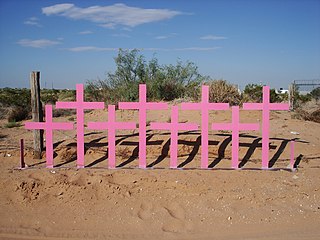
Ciudad Juárez, commonly referred to as just Juárez, is the most populous city in the Mexican state of Chihuahua. It was known until 1888 as El Paso del Norte. Juárez is the seat of the Juárez Municipality with an estimated population of 2.5 million people. It lies on the Rio Grande river, south of El Paso, Texas, United States. Together with the surrounding areas, the cities form El Paso–Juárez, the second largest binational metropolitan area on the Mexico–U.S. border, with a combined population of over 3.4 million people.

More than 500 women were killed between 1993 and 2011 in Ciudad Juárez, a city in northern Mexico. The murders of women and girls received international attention primarily due to perceived government inaction in preventing the violence and bringing perpetrators to justice. The crimes have featured in many dramas, songs, and books.
Abdul Latif Sharif, first name also spelled Abdel, was an Egyptian-born American chemist and chief suspect in the Juárez killings, a decade-long murder spree that began in the Mexican city of Ciudad Juárez in the early 1990s.

Femicide or feminicide is a term for the hate crime of systematically killing women, girls, or females in general because of their gender and/or sex. In 1976, the feminist author Diana E. H. Russell first defined the term as "the killing of females by males because they are female." Femicides are more often perpetrated by men against women. This is most likely due to unequal power between men and women as well as harmful gender roles, stereotypes, or social norms. Though femicide is not purely male-perpetrated but can be female-perpetrated as well.
Nuestras Hijas de Regreso a Casa A.C. is a non-profit organization composed of mothers, family members, and friends of victims of the female homicides in Ciudad Juárez. The mothers claim that their cases have gone unsolved in some cases for over 12 years. Their hope is to get the murderers of their daughters arrested and hopefully convicted.

Crime is one of the most urgent concerns facing Mexico, as Mexican drug trafficking rings play a major role in the flow of cocaine, methamphetamine, fentanyl, heroin, and marijuana transiting between Latin America and the United States. Drug trafficking has led to corruption, which has had a deleterious effect on Mexico's Federal Representative Republic. Drug trafficking and organized crime have been a major source of violent crime. Drug cartels and gangs have also branched out to conduct alternative illegal activities for profit, including sex trafficking in Mexico. Some of the most increasingly violent states in Mexico in 2020 included Guanajuato, Zacatecas, Michoacán, Jalisco, and Querétaro. Some of the world's most violent cities are reportedly within the state of Guanajuato with extortion from criminal groups now being commonplace. The state of Zacatecas is said to be valuable to multiple organized crime groups for drug trafficking, specifically methamphetamine to the United States. As of 2021, Michoacán is experiencing increased instances of extortion and kidnapping due to a growing presence and escalation in the armed conflicts between CJNG and Cárteles Unidos on regions bordering the neighboring state of Jalisco. CJNG is also currently battling the Los Chapitos faction of the Sinaloa Cartel in the North Mexican region of Sonora.

The Mexican drug war is an ongoing asymmetric low-intensity conflict between the Mexican government and various drug trafficking syndicates. When the Mexican military intervened in 2006, the government's main objective was to reduce drug-related violence. The Mexican government has asserted that their primary focus is dismantling the cartels and preventing drug trafficking. The conflict has been described as the Mexican theater of the global war on drugs, as led by the United States federal government.

Crime and violence affect the lives of millions of people in Latin America. Some consider social inequality to be a major contributing factor to levels of violence in Latin America, where the state fails to prevent crime and organized crime takes over State control in areas where the State is unable to assist the society such as in impoverished communities. In the years following the transitions from authoritarianism to democracy, crime and violence have become major problems in Latin America. The region experienced more than 2.5 million murders between 2000 and 2017. Several studies indicated the existence of an epidemic in the region; the Pan American Health Organization called violence in Latin America "the social pandemic of the 20th century." Apart from the direct human cost, the rise in crime and violence has imposed significant social costs and has made much more difficult the processes of economic and social development, democratic consolidation and regional integration in the Americas.
Rates of crime in Guatemala are very high. An average of 101 murders per week were reported in 2018. The countries with the highest crime and violence rates in Central America are El Salvador and Honduras. In the 1990s Guatemala had four cities feature in Latin America's top ten cities by murder rate: Escuintla, Izabal (127), Santa Rosa Cuilapa (111) and Guatemala City (101). According to New Yorker magazine, in 2009, "fewer civilians were reported killed in the war zone of Iraq than were shot, stabbed, or beaten to death in Guatemala," and 97% of homicides "remain unsolved." Much of the violent nature of Guatemalan society stems back to a 36-year-long civil war However, not only has violence maintained its presence in the post-war context of the country following the Guatemalan Civil War, but it has extended to broader social and economic forms of violence.

Susana Chávez Castillo was a Mexican poet and human rights activist who was born and lived most of her life in her hometown of Ciudad Juárez.
Barrio Azteca, or Los Aztecas, is a Mexican-American street and prison gang originally based in El Paso, Texas, USA and Ciudad Juarez, Chihuahua, Mexico. The gang was formed in the Coffield Unit, located near Tennessee Colony, Texas by Jose "Raulio" Rivera, a prisoner from El Paso, in the early 1980s. It expanded into a transnational criminal organization that traded mainly across the US-Mexico border. Currently one of the most violent gangs in the United States, they are said to have over 3,000 members across the country in locations such as New Mexico, Texas, Massachusetts, and Pennsylvania as well as at least 5,000 members in Ciudad Juarez, Mexico.

Violence against women in Guatemala reached severe levels during the long-running Guatemalan Civil War (1960-1996), and the continuing impact of that conflict has contributed to the present high levels of violence against women in that nation. During the armed conflict, rape was used as a weapon of war.
Campo Algodonero in Ciudad Juarez, Chihuahua, Mexico, is the memorial site for hundreds of women who have died during the past two decades. The Algodonero became an important site after eight women were found dead in 2001. This memorial site was recently created after the verdict of the Inter-American Court of Human Rights against the State of Mexico in regards to the case of the Algodonero field where eight women were found dead. The memorial site includes a statue of a woman, made by Veronica Leiton, and multiple pink crosses that represent the women who were found. Campo Algodonero serves as a standing symbol of memory that dwells in the lives of all of the victims’ families who refuse to stay quiet and who are constantly in the middle of controversy.

Desert Blood: The Juarez Murders is a 2005 mystery thriller by author Alicia Gaspar de Alba based on the violence, kidnapping and femicides that occurred in Ciudad Juarez in 1998.

Sergio González Rodríguez was a Mexican journalist and writer who was best known for his works on the femicides in Ciudad Juárez from the 1990s to the 2000s, such as Huesos en el desierto and The Femicide Machine. González Rodríguez was a writer who worked in many literary genres, producing literary journalism or crónicas[es], novels, essays, and screenplays for documentaries. His writing was recognized with several awards in Mexico and Spain.
Alejandro Máynez is a Mexican alleged serial killer and fugitive. Along with Ana Benavides and Melchor Máynez, he killed at least two women in Ciudad Juárez, but he is believed to be responsible for 50 victims in all. His murders are organized and motivated by sexual compulsion, committed as part of a group.
Violence against women in Mexico includes different forms of gender-based violence. It may consist of emotional, physical, sexual, and/or mental abuse. The United Nations (UN) has rated Mexico as one of the most violent countries for women in the world. According to the National Institute of Statistics and Geography in Mexico (INEGI), 66.1 percent of all women ages 15 and older have experienced some kind of violence in their lives. Forty-nine percent have suffered from emotional violence; 29 percent have suffered from emotional-patrimonial violence or discrimination; 34 percent from physical violence; and 41.3 percent of women have suffered from sexual violence. Of the women who were assaulted in some form from 2015 to 2018, 93.7 percent of them did not seek help or report their attacks to authorities.
Ramiro Adame López, also known as The Rio Bravo Assassin among many other aliases, is a Mexican serial killer who was convicted of killing three women in Ciudad Juárez but is suspected of up to 27 more, some of those underage. He was captured and sentenced to prison time for three murders in 1986, but he escaped in 1990 and after remaining a fugitive from justice, he was recaptured in New Mexico and deported from the US back to Ciudad Juárez. On January 24, 2014 he was delivered halfway through the Reforma International Bridge, from Lerdo Avenue by ICE agents to agents from the Mexican Ministerial Police. Currently, he is one of the main suspects in the unsolved femincides in Ciudad Juárez. He was a disorganized, sedentary, hedonistic murderer motivated by sexual compulsion and predatory behaviour.

Femicide, broadly defined as the murder of a woman motivated by gender, is a prevalent issue in Latin America. In 2016, 14 of the top 25 nations with the highest global femicide rates were Latin American or Caribbean states. In 2021, 4,445 women were recorded victims of femicide in the region, translating to the gender-based murder of about one woman every two hours in Latin America.

Femicide is the act of murdering women, because they are women. Mexico, particularly in Ciudad Juárez, is one of the leading countries in the amount of feminicides that occur each year, with as much as 3% of murder victims being classified as feminicide with approximately 1,000 feminicide in 2021, out of 34,000 murder victims. Mexico is also among the leading country in term of murders Murder rate, and 90% of the victims of murder are men. This escalation of violence began in the early 1990s and was followed by a wave of sexual violence and torture, abductions, increasing rates of women being murdered because of their gender. While the number of women murdered in Mexico has grown substantially in recent years, the proportion of female victims of homicide has not actually changed much over the last few decades. According to INEGI, the ratio of homicides targeting women hovered between 10-13% from 1990 to 2020.














